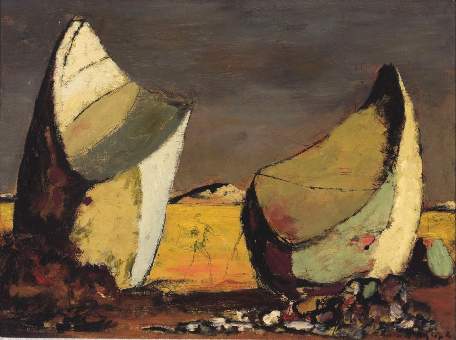Desert Landscape
Russell Drysdale

Details
- Artist
- Russell Drysdale
- Title
- Desert Landscape
- Year
- c.1953
- Medium
- oil on canvas
- Size
- 29 x 39.5cm
- Details
signed lower left: RD
Reproduced courtesy the copyright holder.
- Stock Number
- 280068
Sold This artwork has been sold. Please contact us for similar artworks.
Provenance
American wartime friend of Drysdale
unknown
Nevill Keating Pictures Ltd, London
private collection, Sydney
private collection, Melbourne
Lauraine Diggins Fine Art, Melbourne
private collection, Melbourne
Exhibited
You Beaut Country: A Selection of Australian Paintings 1940 - 2000, Agnes, London 3-26 October 2001, cat. no. 7
Australian Modern: Arte Australiana Moderna e Contemporanae e Arte Aborigena, Fondazione Mudima, Milan, 23 April - 24 May, 2002
''The Painted Vision: 1840 - 1963'', Lauraine Diggins Fine Art, Melbourne, 2009
Literature
Australian Modern: Arte e Australiana Moderna e Contemporanae e Arte Aborigena, exhibition catalogue, Malakoff Fine Art Press, Melbounrne, 2002, illus. p. 5
Further Information
Until the early 1950s Drysdale’s working methods depended solely on the planning out of his canvases with pen and ink, the tracings of which are still visible on the surfaces of his earlier canvas. However, it was with the artist’s discovering of an old master recipe descriptively termed the “black oil” medium, that provided the catalyst for change with “the use of black oil marks the separation of his activities as draughtsman and painter”. The adoption of this technique witnessed a transitional turning point in Drysdale’s style, with his compositions generating a more painterly method, subsequently allowing for greater freedom of application the artist observing that he could “push and pull” the paint about. This freedom extended to his lifestyle as a traveller artist, often driving and camping with his wife and son on expeditions across Northern and Western Australia.
Possibly one the earliest examples of this liberated expression is the sweeping dimensions of Desert Landscape with its gargantuan balancing rocks dominating the foreground. Signalling a foray into the surrealist, with Drysdale “intensifying landscape into symbol, investing the rocks in the foreground with magical qualities”. It is these magical qualities that lend further gravity and ultimately a sympathetic perspective to its ghostly Aboriginal subject. “Aboriginal people had never been treated with such objective compassion and understanding by an artist, and it changed the popular view of Aboriginal people hitherto characterised by the unfeeling and insensitive lampoons of the colonial the tradition.”
Drysdale’s treatment of this subject along with its native landscape were to become typical of his concerns for outback Australia, his historical retrospective experiments with artistic alchemy and the combined results both elements had for his work during the ensuing decade.
Excerpts from discussions with Lou Klepac 2002
